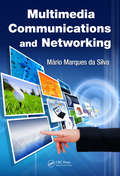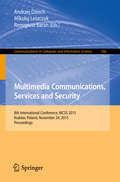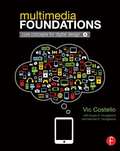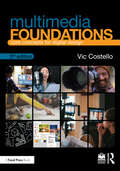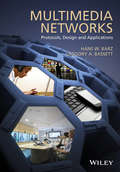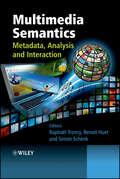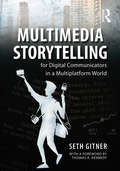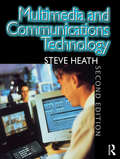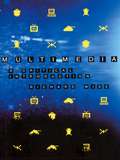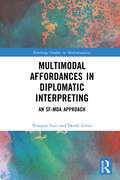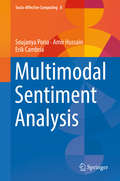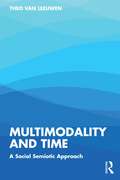- Table View
- List View
Multimedia Communications and Networking
by Mario Marques da SilvaThe result of decades of research and international project experience, Multimedia Communications and Networking provides authoritative insight into recent developments in multimedia, digital communications, and networking services and technologies. Supplying you with the required foundation in these areas, it illustrates the means that will allow
Multimedia Communications, Services and Security
by Andrzej Dziech Mikołaj Leszczuk Remigiusz BaranThis volume constitutes the refereed proceedings of the 8th International Conference on Multimedia Communications, Services and Security, MCSS 2015, held in Krakow, Poland, in November 2015. The 16 full papers included in the volume were selected from 39 submissions. The papers cover ongoing research activities in the following topics: multimedia services; intelligent monitoring; audio-visual systems; biometric applications; experiments and deployments.
Multimedia Foundations
by Vic CostelloUnderstand the core concepts and skills of multimedia production and digital storytelling using text, graphics, photographs, sound, motion, and video. Then, put it all together using the skills that you have developed for effective project planning, collaboration, visual communication, and graphic design. Presented in full color with hundreds of vibrant illustrations, "Multimedia Foundations" trains you in the principles and skill sets common to all forms of digital media production, enabling you to create successful, engaging content, no matter what tools you are using. Companion website features a wealth of web resources, illustrations, and video tutorials demonstrating the key techniques presented in the book. Improve projects with core principles of visual communication and graphic design. Learn necessary strategies for project planning, organization, and asset management. Understand the intricacy of design and production workflows. Effectively navigate postproduction and the distribution of multimedia content. Utilize the companion web site video tutorials and links to go along with each of the chapters.
Multimedia Foundations
by Vic CostelloUnderstand the core concepts and skills of multimedia production and digital storytelling using text, graphics, photographs, sound, motion, and video. Then, put it all together using the skills that you have developed for effective project planning, collaboration, visual communication, and graphic design. Presented in full color with hundreds of vibrant illustrations, "Multimedia Foundations" trains you in the principles and skill sets common to all forms of digital media production, enabling you to create successful, engaging content, no matter what tools you are using. Companion website features a wealth of web resources, illustrations, and video tutorials demonstrating the key techniques presented in the book. Improve projects with core principles of visual communication and graphic design. Learn necessary strategies for project planning, organization, and asset management. Understand the intricacy of design and production workflows. Effectively navigate postproduction and the distribution of multimedia content. Utilize the companion web site video tutorials and links to go along with each of the chapters.
Multimedia Foundations: Core Concepts for Digital Design
by Vic CostelloUnderstand the core concepts and skills of multimedia production and digital storytelling using text, graphics, photographs, sound, motion, and video. Then, put it all together using the skills that you have developed for effective project planning, collaboration, design, and production. Presented in full color with hundreds of vibrant illustrations, Multimedia Foundations, Second Edition trains you in the principles and skill sets common to all forms of digital media production, enabling you to create successful, engaging content, no matter what tools you are using. The second edition has been fully updated and features a new chapter on video production and new sections on user-centered design, digital cinema standards (2K, 4K, and 8K video), and DSLR and video camcorder recording formats and device settings. The companion website, which features a wealth of web resources, glossary terms, and video tutorials, has also been updated with new content for both students and instructors.
Multimedia Foundations: Core Concepts for Digital Design
by Vic CostelloWhether you are working using text, graphics, photography, sound, motion, or video, Multimedia Foundations covers the skills necessary to be an effective modern storyteller. Presented in full color with hundreds of vibrant illustrations, this book trains readers in the principles and skills common to all forms of digital media production, enabling the creation of successful, engaging content, no matter what tools are used. Chapters feature useful exercises to cement core concepts and help readers develop planning, collaboration, design, and production skills. This third edition has been fully updated and includes new and revised illustrations, updated coverage of digital asset management and media workflows, a completely rewritten chapter on coding for web and mobile media, and new sections on design thinking, inclusive design, color theory, photography composition, interview and B-roll acquisition techniques, and editing stages and postproduction workflows. Multimedia Foundations is a comprehensive resource for students in fields such as journalism, film production, animation and game design, web and graphic design, and other areas where modern media is produced. A website with Instructor and Student Resources for this book includes a glossary of terms, chapter PowerPoints, and sample text banks.
Multimedia Networks
by Hans W. Barz Gregory A. BassettThe transportation of multimedia over the network requires timely and errorless transmission much more strictly than other data. This had led to special protocols and to special treatment in multimedia applications (telephony, IP-TV, streaming) to overcome network issues. This book begins with an overview of the vast market combined with the user's expectations. The base mechanisms of the audio/video coding (H.26x etc.) are explained to understand characteristics of the generated network traffic. Further chapters treat common specialized underlying IP network functions which cope with multimedia data in conjunction which special time adaption measures. Based on those standard functions these chapters can treat uniformly SIP, H.248, High-End IP-TV, Webcast, Signage etc. A special section is devoted to home networks which challenge high-end service delivery due to possibly unreliable management. The whole book treats concepts described in accessible IP-based standards and which are implemented broadly. The book is aimed at graduate students/practitioners with good basic knowledge in computer networking. It provides the reader with all concepts of currently used IP technologies of how to deliver multimedia efficiently to the end user.
Multimedia Processing, Communication and Computing Applications: Proceedings of the First International Conference, ICMCCA, 13-15 December 2012
by Devanur S. Guru Punitha P. SwamyICMCCA 2012 is the first International Conference on Multimedia Processing, Communication and Computing Applications and the theme of the Conference is chosen as 'Multimedia Processing and its Applications'. Multimedia processing has been an active research area contributing in many frontiers of today's science and technology. This book presents peer-reviewed quality papers on multimedia processing, which covers a very broad area of science and technology. The prime objective of the book is to familiarize readers with the latest scientific developments that are taking place in various fields of multimedia processing and is widely used in many disciplines such as Medical Diagnosis, Digital Forensic, Object Recognition, Image and Video Analysis, Robotics, Military, Automotive Industries, Surveillance and Security, Quality Inspection, etc. The book will assist the research community to get the insight of the overlapping works which are being carried out across the globe at many medical hospitals and institutions, defense labs, forensic labs, academic institutions, IT companies and security & surveillance domains. It also discusses latest state-of-the-art research problems and techniques and helps to encourage, motivate and introduce the budding researchers to a larger domain of multimedia.
Multimedia Reporting: How Digital Tools Can Improve Journalism Storytelling (Tsinghua Global Business Journalism Series)
by Richard Scott DunhamThis is the first book to apply multimedia tools to economic and business storytelling. By examining the journalism essentials as well as the advanced multimedia skills, it helps readers use the latest technological tools to integrate multimedia elements into traditional news coverage. It also explains how to tell stories solely through multimedia elements. The new language of online journalism includes writing for digital platforms, writing blogs and writing for social media and involves a wide range of multimedia skills, like video, audio, photography, graphics, data visualization and animation. Multimedia journalism allows a two-way communication with the audience that was not possible in traditional “legacy” media, and this textbook is replete with links to useful tutorials, examples of award-winning multimedia stories, and advanced digital resources, offering journalists a road map to the brave new world of digital reporting and editing.
Multimedia Semantics
by Simon Schenk Raphael Troncy Benoit HuetIn this book, the authors present the latest research results in the multimedia and semantic web communities, bridging the "Semantic Gap"This book explains, collects and reports on the latest research results that aim at narrowing the so-called multimedia "Semantic Gap": the large disparity between descriptions of multimedia content that can be computed automatically, and the richness and subjectivity of semantics in user queries and human interpretations of audiovisual media. Addressing the grand challenge posed by the "Semantic Gap" requires a multi-disciplinary approach (computer science, computer vision and signal processing, cognitive science, web science, etc.) and this is reflected in recent research in this area. In addition, the book targets an interdisciplinary community, and in particular the Multimedia and the Semantic Web communities. Finally, the authors provide both the fundamental knowledge and the latest state-of-the-art results from both communities with the goal of making the knowledge of one community available to the other.Key Features:Presents state-of-the art research results in multimedia semantics: multimedia analysis, metadata standards and multimedia knowledge representation, semantic interaction with multimediaContains real industrial problems exemplified by user case scenariosOffers an insight into various standardisation bodies including W3C, IPTC and ISO MPEGContains contributions from academic and industrial communities from Europe, USA and AsiaIncludes an accompanying website containing user cases, datasets, and software mentioned in the book, as well as links to the K-Space NoE and the SMaRT society web sites (http://www.multimediasemantics.com/)This book will be a valuable reference for academic and industry researchers /practitioners in multimedia, computational intelligence and computer science fields. Graduate students, project leaders, and consultants will also find this book of interest.
Multimedia Storytelling for Digital Communicators in a Multiplatform World
by Seth GitnerMultimedia Storytelling for Digital Communicators in a Multiplatform World is a unique guide for all students who need to master visual communication through multiple media and platforms. Every communication field now requires students to be fluent in visual storytelling skill sets, and as the present-day media adapt to a multiplatform world (with ever-increasing delivery systems from desktops to cell phones), students specializing in different forms of communication are discovering the power of merging new multimedia technology with very old and deep-rooted storytelling concepts. Award-winning journalist and multimedia professor Seth Gitner provides students with the tools for successfully realizing this merger, from understanding conflict, characters, and plot development to conducting successful interviews, editing video in post-production, and even sourcing royalty-free music and sound effects. Incorporating how-to’s on everything from website and social media optimization to screenwriting, Multimedia Storytelling aims to be a resource for any student who needs to think and create visually, in fields across broadcast and digital journalism, film, photography, advertising, and public relations. The book also includes a range of supplemental material, including wide-ranging skills exercises for each chapter, interviews with seasoned professionals, key terms, and review questions.
Multimedia Storytelling for Digital Communicators in a Multiplatform World
by Seth GitnerNow in its second edition, Multimedia Storytelling for Digital Communicators in a Multiplatform World is a trusted guide for all students who need to master visual communication through multiple media and platforms. Incorporating how-to’s on everything from website and social media optimization to screenwriting, this textbook provides readers with the tools for successfully merging new multimedia technology with very old and deep-rooted storytelling concepts. Topics covered include: how to understand conflict, characters, and plot development; conducting successful interviews; editing video in post-production; and sourcing royalty-free music and sound effects. The book also includes a range of supplemental material, including exercises for each chapter, interviews with seasoned professionals, key terms, and review questions. New to this edition are thoroughly updated chapters on social media storytelling, visual storytelling with mobile devices, and post-production techniques, to reflect current industry trends. This book is a key resource for students learning to think and create visually in fields across broadcast and digital journalism, film, photography, advertising, and public relations.
Multimedia Streaming in SDN/NFV and 5G Networks: Machine Learning for Managing Big Data Streaming (IEEE Press)
by Alcardo Barakabitze Andrew HinesMultimedia Streaming in SDN/NFV and 5G Networks A comprehensive overview of Quality of Experience control and management of multimedia services in future networks In Multimedia Streaming in SDN/NFV and 5G Networks, renowned researchers deliver a high-level exploration of Quality of Experience (QoE) control and management solutions for multimedia services in future softwarized and virtualized 5G networks. The book offers coverage of network softwarization and virtualization technologies, including SDN, NFV, MEC, and Fog/Cloud Computing, as critical elements for the management of multimedia services in future networks, like 5G and 6G networks and beyond. Providing a fulsome examination of end-to-end QoE control and management solutions in softwarized and virtualized networks, the book concludes with discussions of probable future challenges and research directions in emerging multimedia services and applications, 5G network management and orchestration, network slicing and collaborative service management of multimedia services in softwarized networks, and QoE-oriented business models. The distinguished authors also explore: Thorough introductions to 5G networks, including definitions and requirements, as well as Quality of Experience management of multimedia streaming services Comprehensive explorations of multimedia streaming services over the internet and network softwarization and virtualization in future networks Practical discussions of QoE management using SDN and NFV in future networks, as well as QoE management of multimedia services in emerging architectures, including MEC, ICN, and Fog/Cloud Computing In-depth examinations of QoE in emerging applications, 5G network slicing architectures and implementations, and 5G network slicing orchestration and resource management Perfect for researchers and engineers in multimedia services and telecoms, Multimedia Streaming in SDN/NFV and 5G Networks will also earn a place in the libraries of graduate and senior undergraduate students with interests in computer science, communication engineering, and telecommunication systems.
Multimedia and Communications Technology
by Steve HeathMultimedia and Communications Technology is a practical explanation of the technologies that bring together existing products such as the PC, telephone and television. It is precisely this revolution that the book addresses - offering an up to date technical overview of developments in PC technology, video and audio compression, telecommunications and many other disciplines. Written as a series of tutorials, the book starts with the fundamental techniques of digital audio and video, moving on to compression techniques such as JPEG and MPEG. The delivery systems for multimedia are then covered, starting with the CD and on to telephones, local and wide area networks and ATM and ASDL. The final chapters describe how these technologies are brought together in some key applications:· video conferencing· digital video broadcasting· video on demand · interactive televisionSteve Heath is responsible for European Strategy and Technology Development at Motorola. He has had many years experience in computer design and has presented papers on multimedia technology at international conferences. He is a well known technical writer and has written fourteen other books for Focal Press, Newnes and Butterworth-Heinemann.
Multimedia and Image Management: Activities
by Karen Bean Susan E. L. LakeMost of the applications discussed within this book are available for both the Windows and Macintosh operating systems, and the activities described can be worked easily on either system.
Multimedia and Ubiquitous Engineering
by James J. Park Hwa Young Jeong Borgy Waluyo Joseph Kee-Yin NgThe new multimedia standards (for example, MPEG-21) facilitate the seamless integration of multiple modalities into interoperable multimedia frameworks, transforming the way people work and interact with multimedia data. These key technologies and multimedia solutions interact and collaborate with each other in increasingly effective ways, contributing to the multimedia revolution and having a significant impact across a wide spectrum of consumer, business, healthcare, education, and governmental domains. Multimedia and Ubiquitous Engineering provides an opportunity for academic and industry professionals to discuss recent progress in the area of multimedia and ubiquitous environment including models and systems, new directions, novel applications associated with the utilization and acceptance of ubiquitous computing devices and systems.
Multimedia over Cognitive Radio Networks: Algorithms, Protocols, and Experiments
by Sunil Kumar Fei HuWith nearly 7 billion mobile phone subscriptions worldwide, mobility and computing have become pervasive in our society and business. Moreover, new mobile multimedia communication services are challenging telecommunication operators. To support the significant increase in multimedia traffic-especially video-over wireless networks, new technological
Multimedia: A Critical Introduction
by Richard WiseMultimedia: A Critical Introduction is a comprehensive guide to the new media form which has resulted from the application of computer technology to existing techniques of broadcasting and telecommunications transmission. The rapid growth of multimedia technologies such as the internet, e-mail and digital television holds the promise of a new 'information age' in which individual tastes are catered for, citizens become better informed, and new wealth is created. But are new media technologies really designed to achieve these utopian aims?Multimedia: a critical introduction provides a historical, cultural and political context to the development of multimedia, as both a technology and a concept. Individual chapters address:* the origins of multimedia in the unlikely interaction between the military and 1960s counter-culture: how the phenomenal US budgets allocated to US military research resulted in the microchip, and why the efforts of counter-culture computer hobbyists evolved into a multi-billion dollar industry.*the wider democratic and cultural implications of multimedia in the wake of the deregulation of the media industries by 'new right' governments in the 1980s, which has led to the domination of the media by transnational conglomerates.* issues of privacy and censorship in relation to new media, including discussion of cryptography, electronic surveillance, and attempts to regulate material such as pornography on the internet.* the use of digital technology to create special effects in feature films.
Multimodal Affordances in Diplomatic Interpreting: An SF-MDA Approach (Routledge Studies in Multimodality)
by Derek Irwin Xinqiao CenThis book offers an in-depth exploration of diplomatic interpreting as a complex form of multimodal interaction, drawing on examples from China–U.S. diplomatic interpreting activities to demonstrate the nuances of meaning transfer across modes and contexts.The volume introduces the notion of interpreting being inherently multimodal through its employment of a range of semiotic repertoires, including linguistic modes, gesture, audial information, spatial arrangement, and visual imagery. Featuring case studies from China–U.S. diplomatic interpreting scenarios, Cen and Irwin examine the means and reasons by which interpreters mediate the range of multimodal semiotic resources in such situations in order to accommodate different meanings across varied contexts and their strategies for contextualizing and recontextualizing meaning while navigating different diplomatic interests and interpersonal relationships. Taken together, the book outlines a new framework for understanding and analyzing bilateral interpreting through a multimodal lens, with implications for interpreting in international studies on a wider scale.This volume will be valuable reading for students and scholars in interpreting studies, applied linguistics, intercultural communication, and international relations.
Multimodal Analysis in Academic Settings: From Research to Teaching (Routledge Studies in Multimodality)
by Belinda Crawford Camiciottoli Inmaculada Fortanet-GómezThis volume presents innovative research on the multimodal dimension of discourse specific to academic settings, with a particular focus on the interaction between the verbal and non-verbal in constructing meaning. Contributions by experienced and emerging researchers provide in-depth analyses in both research and teaching contexts, and consider the ways in which multimodal strategies can be leveraged to enhance the effectiveness of academic communication. Contributors employ both quantitative and qualitative analytical methods, and make use of state-of-the-art software for analyzing multimodal features of discourse. The chapters in the first part of the volume focus on the multimodal features of two key research genres: conference presentations and plenary addresses. In the second part, contributors explore the role of multimodality in the classroom through analyses of both instructors’ and students’ speech, as well as the use of multimodal materials for more effective learning. The research presented in this volume is particularly relevant within the context of globalized higher education, where participants represent a wide range of linguistic and cultural backgrounds. Multimodal Analysis in Academic Settings contributes to an emerging field of research with importance to an increasing number of academics and practitioners worldwide.
Multimodal Approaches to Chinese-English Translation and Interpreting (Routledge Advances in Translation and Interpreting Studies)
by Zhang Meifang Feng DezhengNowadays, discourse analysis deals with not only texts but also paratexts and images, so do translation and interpreting studies. Therefore, the concept of "multimodality" has become an increasingly important topic in subject areas of linguistics, discourse analysis and translation studies. However, up to now, not much research has been done systematically on multimodal factors in translation and interpreting, even less in exploring research models or methodologies for multimodal analysis in translation and interpreting. This book aims to introduce and apply different theories of the multimodal discourse analysis to the study of translations, with case studies on Chinese classics such as the Monkey King, Mulan and The Art of War, as well as on interpretations of up-to-date issues including the Chinese Bell and Road Initiative and Macao tourism. The chapters reflect the first attempts to apply multimodal approaches to translation and interpreting with a special focus on Chinese-English translations and interpreting. They provide new understandings of transformations in the multimodal translation process and useful reference models for researchers who are interested in doing research of similar kind, especially for those who are interested in looking into translations related to Chinese language, literature and culture.
Multimodal Sentiment Analysis (Socio-Affective Computing #8)
by Amir Hussain Erik Cambria Soujanya PoriaThis latest volume in the series, Socio-Affective Computing, presents a set of novel approaches to analyze opinionated videos and to extract sentiments and emotions. Textual sentiment analysis framework as discussed in this book contains a novel way of doing sentiment analysis by merging linguistics with machine learning. Fusing textual information with audio and visual cues is found to be extremely useful which improves text, audio and visual based unimodal sentiment analyzer. This volume covers the three main topics of: textual preprocessing and sentiment analysis methods; frameworks to process audio and visual data; and methods of textual, audio and visual features fusion. The inclusion of key visualization and case studies will enable readers to understand better these approaches. Aimed at the Natural Language Processing, Affective Computing and Artificial Intelligence audiences, this comprehensive volume will appeal to a wide readership and will help readers to understand key details on multimodal sentiment analysis.
Multimodales Framing
by Anna-Maria VolpersIn diesem Buch führt Anna-Maria Volpers den kommunikationswissenschaftlichen Framing-Ansatz mit der interdisziplinären Forschung zu visueller und multimodaler Kommunikation zusammen. Dabei werden sowohl Theorien und Methoden als auch der Stand der empirischen Forschung betrachtet. Die Autorin gibt zunächst einen Überblick über die allgemeine (verbale) Framing-Forschung. Anschließend werden Grundlagen der visuellen und multimodalen Kommunikation aus Perspektive der Semiotik, Linguistik und Psychologie erläutert. Es folgt eine systematische Analyse des Forschungsstands zu Bildern und Multimodalität. Diese umfasst Medien-Frames, strategisches und journalistisches Framing sowie Rezeption und Wirkung von Frames. Im Ergebnis werden Desiderate und Anforderungen an empirische Studien formuliert und eine interdisziplinäre Landkarte der multimodalen Framing-Forschung gezeichnet.
Multimodality and Time: A Social Semiotic Approach
by Theo van LeeuwenThis ground-breaking book brings together the work of leading theorist, Theo van Leeuwen, on time-based multimodal forms of communication including speech, music, and film.With chapters on the fundamental meaning-making role of rhythm, time in music, time in film, the representation of time and timing in language, and the visualization of time, this book offers a comprehensive approach to the subject that supplements the author’s earlier work on visual communication. This book is richly illustrated with examples, including analyses of time management texts, everyday interactions such as waitressing in a restaurant, classic and contemporary films, television crime series and documentaries, a wide variety of kinds of music, online educational software, and SmartArt templates for the diagrammatic representation of time-based practices. Every chapter also includes questions and exercises to reinforce and extend learning. Written in an accessible style, it will be essential reading for students, teachers, and researchers in the field of multimodal communication, whether in communication studies, media studies, or linguistics.
Multimodality in Translation Studies: Media, Models, and Trends in China
by Hong Qian Tian Luo Li Pan Xiaoping WuFocusing on multimodality in translation studies, this edited volume provides insights into the trends and practices of multimodal translation in a variety of media. Divided into four main themes, the book explores audiovisual translation in digital media, multimodal translation of Chinese classics, multimodal design in website translation, and the use of paratexts in conference interpreting. Contributors draw on a diverse range of methods and theoretical models, including systemic functional multimodal discourse analysis, narrative theory, Skopos-functional theory, multimodal analysis of digital discourse, and corpus-based multimodal analysis. It covers important topics in media translation, ranging from emerging multimodal translation models to multimodal creativity in interlingual subtitling for social media and identity construction in the multimodal translation of food advertising. Through robust empirical studies, the book aims to shed light on the methodological development of multimodal translation in different media forms, including social media, websites, on-site interactions and books. The title will be of great value to scholars and students of linguistics, translation studies, multimodal discourse analysis and digital media.
